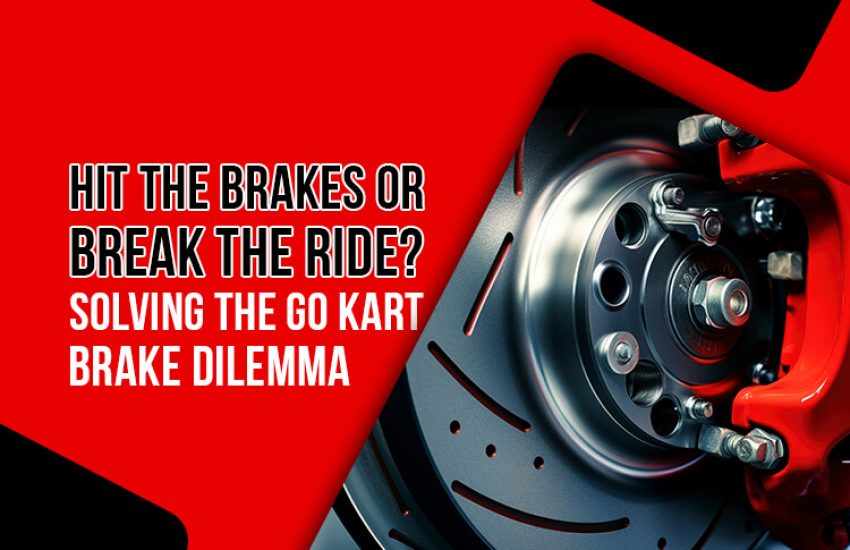Having issues with your go kart’s brakes?
It’s super frustrating and even dangerous when the brakes fail or don’t work properly.
But don’t worry – it’s easy to fix.
There are only a few areas to check if your go-kart suddenly loses braking power or the brakes feel spongy or soft. Some fixes can be DIY. But for others, you might need to replace parts.
In this guide, I’ll go over the reasons why your go kart brakes are not working and point you in the right direction for fixing each of the issues.
Table of Contents
Toggle#1 Worn Out Brake Band / Pads
The most common reason behind why go kart brakes not working is worn-out brake pads (if you have hydraulic brakes) or a brake band (if you have band brakes).
Friction is what brings your go-kart to a halt, and when the brake pads are thin or glazed over, they simply don’t grip the drums or discs effectively.
Also Read: Go Kart Clutch Making Noise?
Common Indicators:
- Spongy brake pedal
- Increased braking distance
- Squealing or grinding noises when braking
- Looks worn out
#2 Worn Brake Cables
Brake cables are the thin wires running from your pedal to the brakes. They transmit your pedal pressure to the brakes.
As time goes on, these cables get all worn out or rusted from being out in the weather. And, the inner wires start to stretch too much because they are worn.
If the cables are worn, they can’t transfer the force to the brakes as they should.
So, even if you press the pedal really hard, it won’t apply enough pressure to slow down.
Common Indicators:
- The pedal moves side to side when pressed
- Pedal feels loose
- Inconsistent braking
- Visible stretching, fraying, or corrosion on the outer cable housing
#3 Air In Brake Lines
Hydraulic brake systems work by using brake fluid that doesn’t compress to transmit your pedal action through the lines to the calipers or wheel cylinders.
Also Read: Mistakes And Tips To Boost Go-Kart Braking
However, as time goes on, air bubbles and pockets can sneak into the fluid.
These air bubbles act like little shock absorbers.
When you hit the pedal, it’s not directly reaching the brake pads or shoes because you’re first compressing these air bubbles.
So, you end up having to push the pedal harder and go deeper to build up the hydraulic pressure needed to bring the go-kart to a stop.
Common Indicators:
- Spongy brake pedal
- Increased braking distance
- Brakes may feel like they “pulse” when applied.
#4 Damaged Parts
In some cases, the problem might lie with the internal components of your brake system.
On disc brake systems, the inner seals of the master cylinder can wear out. This lets the fluid slip past the pistons instead of going where it should in the lines.
The slide pins on the calipers can also get stuck, which can prevent the brake pads from touching the rotor evenly.
Drum brake issues include worn or damaged brake shoes, anchor pins, or return springs.
Common Indicators:
- Uneven braking performance
- Pulling to one side when braking
- Grinding noises
- Complete brake failure
#5 Brake Fluid Leaking
Brake systems rely on hydraulic pressure to transfer force from the pedal to the wheels.
So, when there are fluid leaks, it’s a problem – it lowers the pressure in the brake lines and lets air bubbles get in.
Both of these things mess with how well your pedal pushes to brake calipers or wheel cylinders.
The most common leak sources are aging seals and blown fittings around the master cylinder, calipers, or wheel cylinders.
But cracked housing damage from impacts or corrosion can also appear over time.
Also Read: How To Lift A Go-Kart
Common Indicators:
- Soft brake pedal
- Increased braking distance
- Visible brake fluid leaks near the master cylinder, calipers, or wheel cylinders.
What To Do If Go Kart Brakes Not Working
Here’s how to fix each go kart brake issue:
Replace Worn Brake Pads & Cables
First, inspect your brake band or pads for wear.
Also, check if the surface where they rub against is clean and doesn’t have any oil, which can really mess up the grip.
If they’re thin or damaged, you have to replace them with new ones.
After that, check cables for damage or signs of stretching. If they are damaged, you need to replace them.
Bleed Your Brakes
If there are air bubbles in your brakes, you need to bleed your brakes to remove air from the system.
Here’s a good guide on how to do that.
Replace Damaged Parts
You’ll have to inspect all of these parts and see if anything is damaged or worn out.
Depending on the severity and your skill level, you might be able to repair or replace the affected parts yourself, but consulting a mechanic is often recommended for more complex issues.
Seal Brake Fluid Leaks
If there are leaks, you need to locate the source of the leak and seal it immediately.
Depending on the severity, you might need to replace damaged components or top up your brake fluid level.
Go Kart Brakes Locked Up

Go-kart brakes can lock up when the brake is not aligned properly, or if the brake cable is stuck or rusted.
You have to lubricate the cable and inspect for damage, and replace the cable if necessary.
It can also happen if brake pads are glazed.
Overheated pads and rotors can become glazed over, forming a glossy hardened surface rather than grippy friction material. This makes the brakes grab suddenly and aggressively.



